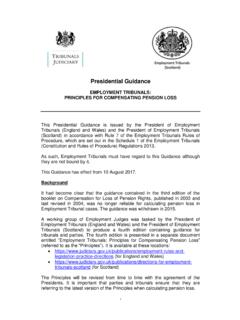Transcription of International Visitors Guide - Judiciary
1 The Judicial System of England and Wales A visitor s guide2 Prepared by the Judicial Office International Team Email: Judicial System of England and Wales: A Visitor s Guide3 IntroductionThe Judiciary of England and Wales and Her Majesty s Courts and Tribunals Service pride themselves on their friendly and effective relations with other judiciaries around the world. Every year we welcome many judges from other countries who are keen to learn more about our legal system. What you see today has evolved over 1,000 years; the Judiciary is continuing to change and develop to meet the needs of our society and is widely regarded as one of the best and most independent in the world. To meet the needs of society, our legal system is also complex. The International Team of the Judicial Office has produced a Visitors Guide to bring together a wealth of information about our Judiciary and legal system it also provides an introduction to the work of organisations, such as the Ministry of Justice and the Crown Prosecution Service which support the justice believe this Guide will be an invaluable resource for any foreign visitor seeking to learn more about England and Wales today, the Judiciary of England & Wales and the English and Welsh legal system, and that it will enhance the quality of your visit.
2 Please do take the time to read it. The excellent website for the Judiciary covers many of the topics discussed in this Guide in more detail. I am grateful to the International Team for their work on compiling this Guide . I very much hope your visit to England and Wales is productive and Justice Arden DBEHead of International Relations for the Judiciary of England and WalesHead of International Relations for the Judiciary of England and WalesLady Justice ardenThe Judicial System of England and Wales: A Visitor s Guide4 ContentsPart 1: Courts and Tribunals 6 The Supreme Court 7 The Court of Appeal 8 The High Court 9 What are Circuits? 11 Part 2: The justice system 17 Sentences 19 Other parts of the justice system 20 Sources of law 23 Civil law 24 Common law 24 The Judiciary s relationship with the supranational courts 26 Change and reform 28 History and myths 29 Part 3: Judges in England and Wales 32 The Lord Chief Justice 32 The Heads of Division 32 The Court of Appeal 32 High Court Judges 33 Circuit Judges 33 Recorders 33 Contents5 The Judicial System of England and Wales: A Visitor s GuideDistrict Judges 33 District Judges (Magistrates Courts) 34 Magistrates (Justices of the Peace) 34 Masters and Registrars 35 Coroners 35 Part 4.
3 Judicial Governance and administrative responsibilities 38 Additional responsibilities 38 Inquiries and Inquests 41 The independence of the Judiciary 42 The process by which the Judiciary governs itself 44 Judicial appointments 46 Swearing in and the judicial oath 47 The Judicial Office 50 The Judiciary and the media 51 International team 51 ContentsThe Judicial System of England and Wales: A Visitor s Guide6 The Structure of the CourtsUK Supreme Court Appeal only, on points of law Justices of the Supreme CourtCourt of AppealAppeal only, on points of law to either the Criminal or Civil Divisions: Lord Chief Justice, Heads of Division and Court of Appeal judgesHigh CourtChancery, Queen s Bench and Family Divisions. All three divisions hear appeals from other courts, as well as first instance Court and Deputy High Court JudgesCrown CourtJury trial for all indictable and some either-way criminal offences.
4 Appeals against conviction and sentence from the magistrates judges, Recorders and juriesCounty CourtTrial for most civil judges, Recorders, District Judges, Deputy District JudgeMagistrates CourtTrial for most criminal offences. Some civil matters. Magistrates, District Judges (Magistrates Courts), Deputy DJ (MC)sEmployment Appeal TribunalAppeals from the Employment TribunalsEmployment Appeal Judges and membersEmployment Tribunal (England Scotland)Claims about matters to do with employmentEmployment Judges and membersFirst-tier TribunalAppeals from executive agency decisionsTribunal Judges and membersThere are a number of other tribunals outside of this structure (for example, School Exclusion Panels) - their supporting legislation explains their individual appeal routes. Upper TribunalAppeals from the First-tier TribunalUpper Tribunal Judges Family CourtTrial for most family Court Judges, Circuit judges, Recorders, District Judges, Deputy District Judge and MagistratesPart 1: Courts and TribunalsThe diagram below illustrates the structure of the court system.
5 Please note that the arrows indicate the route of appeal through the different courts. The Judicial System of England and Wales: A Visitor s Guide7 Courts and TribunalsThis is the final court of appeal in the United Kingdom1. It hears appeals on arguable points of law of the greatest public importance, for the whole of the United Kingdom in civil cases, and for England, Wales and Northern Ireland in criminal cases. In Scotland, appeals can be made from the lower courts in criminal cases to the High Court of Justiciary, which is Scotland s supreme criminal court. Although it is the highest Court of Appeal in the United Kingdom, the Supreme Court must give effect to directly applicable European Union law, and interpret domestic law in a way that is consistent with it, so far as possible. It must also give effect to the rights contained in the European Convention on Human Rights and take account of any decision of the European Court of Human Rights (ECHR) in Strasbourg.
6 The Supreme Court must also refer to the 1 A Court of Appeal, also known as an appellate court, hears cases from the lower courts, which in turn hear cases at first of Justice of the European Union (CJEU) in Luxembourg any question on European Union law, where the answer is not clear and it is necessary for it to give judgment. The Supreme Court also decides devolution issues , concerning the devolved executive and legislative authorities in Scotland, Wales and Northern Ireland. Permission to appeal will be given only if a case raises a point of general public importance. Cases are heard by five, seven or nine of the twelve Justices of the Supreme Court, each of whom reaches an individual decision, their overall verdict being achieved either by unanimity or a simple majority. Decisions made in the Supreme Court and the Court of Appeal become precedents that must be followed by courts in all future Supreme CourtHistory of the Supreme CourtThe Supreme Court was established in 2009 to achieve a complete separation between the United Kingdom s senior Judges and the Upper House of Parliament, emphasising the independence of the Law Lords and increasing the transparency between Parliament and the courts.
7 (The Law Lords, also known as Lords of Appeal in Ordinary, were highly qualified, full-time judges who carried out the judicial work of the House of Lords until July 2009, when they left Parliament to become the Justices of the new United Kingdom Supreme Court).The Judicial System of England and Wales: A Visitor s Guide8 Courts and TribunalsThe Court of Appeal and the High Court constitute what are called the Senior Courts of England and Wales. It is an appellate court and is divided into two divisions, Criminal and Civil. Bringing an appeal is subject to obtaining permission , which may be granted by the High Court or, more usually, by the Court of Appeal itself. Applications for permission to appeal are commonly determined by a single judge of the Court of Appeal. Cases are generally heard by three judges, consisting of any combination of the Heads of Division (who lead the different jurisdictions of the courts of England and Wales see below), and the Lord Justices of Appeal, who are the most senior judges, with lengthy judicial experience who hear cases on appeal; it is from these judges that the Heads of Division are Civil Division hears appeals in all leading cases in civil and family justice from the High Court and, in some instances, from the County Courts and certain tribunals as well such as the Employment Appeal Tribunal.
8 In a Court of Appeal civil court, there is a bench of three Lord or Lady Justices2. 2 A bench is the location in the courtroom where the Each of the three judges reaches an individual decision. The Court s overall verdict can be made either unanimously or by a two-to-one majority. When this happens, the judge who is in the minority gives a dissenting (disagreeing) judgment, explaining why they do not agree with the others. The Criminal Division hears appeals in criminal matters from the Crown Court and points of law referred by the Attorney General following acquittal in the Crown Court or where the sentence imposed was unduly lenient. The bench in this Division usually consists of a Lord or Lady Justice and two High Court judges - they hear appeals against conviction and sentence. The most important Criminal appeal cases are often heard by the Lord Chief Justice, the President of the Queen s Bench Division or the Vice-President of the Court of Appeal Criminal Division, sitting with two judges of the High Court.
9 Their decisions are always unanimous; if one judge disagrees, he or she will follow the others and not give a dissenting judgment. judge sits. The term is also used to describe judges collectively, or a group of judges within a particular court or division. The Court of AppealThe Judicial System of England and Wales: A Visitor s Guide9 Courts and TribunalsThe High CourtThis court hears the more serious and complex civil and family cases at first instance. It contains three divisions - Queen s Bench, Family and Chancery. Each of these has a judicial `Head . The Head of the Chancery Division is known as the Chancellor of the High Court (not to be confused with the Lord Chancellor). The Queen s Bench Division and the Family Division are both led by a President. The Divisions of the High CourtThe Queen s Bench Division is the biggest of the three High Court Divisions, and has the most varied jurisdiction.
10 Included within it are a number of specialist courts: the Admiralty, Commercial, Mercantile, Technology & Construction, and Administrative Courts. Part of the civil work of the Division is handling those contract and tort (civil wrongs) cases which are unsuitable for the county courts for reasons of cost or complexity. It also handles libel cases. In London, this work is administered in the Central Office at the Royal Courts of Justice by the Senior Master with the support of the Judge in Charge of the Queen s Bench Civil list, acting under the authority of the President of the Queen s Bench Division. Outside London, the Division s work is administered in provincial offices known as District Registries. The Admiralty Court is the oldest of all the Division s specialist courts and deals principally with the legal consequences of collisions at sea, salvage, and damage to cargoes.















